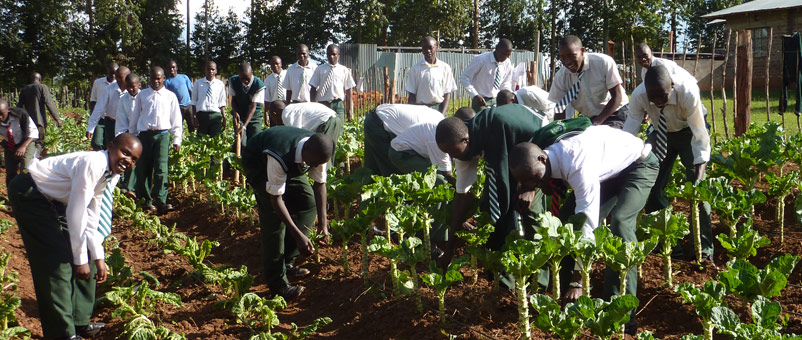The Paris Climate Agreement entered into force last week, heralding a major milestone in international action on climate change, and an ambitious target to contain global temperature rise to well below 2°C above pre-industrial levels, in this century. Over 100 countries, which account for nearly 70% of global emissions, have ratified the Agreement, and are now obliged to deliver on their commitments and convert their plans into action. But unless countries act decisively and meaningfully, and increase their ambitions over time, this will not be enough to safeguard food and farming.

Figure 1. Gap between the current collective ambition of national climate plans (known as NDCs) and the global 2°C goal. Source: Adapted from Rogelj et al. 2016 in Vermeulen 2016.
Future food security in a changing climate
The Paris Agreement is made up of Intended Nationally Determined Contributions (INDCs), which are climate action plans developed by countries, outlining their priorities and measures. The INDCs of countries overwhelmingly put agriculture the top of the list for climate action; over 60% of submitted INDCs included mitigation in agriculture. And of the countries which included adaptation, over 90% included adaptation in agriculture. African countries in particular have expressed a clear desire to tackle these issues: 98% of African countries included adaptation actions in agriculture and 68% included mitigation actions in agriculture.

Figure 2. Inclusion of agriculture in climate pledges (INDCs). Source: Richards et al 2016 in Vermeulen et al 2016.
However, effective implementation will depend on the availability of financial, technological and capacity support. In fact, some countries have made several commitments conditional upon the provision of support.
Mobilizing support for climate actions
Fortunately, the Paris Agreement has set out robust frameworks to provide much-needed support and the UNFCCC’s finance mechanism, particularly the Green Climate Fund, will play a key role: US$10.3 billion have been pledged to the Fund, and the Fund has committed US$ 1.2 billion to 27 projects. But this still falls short of the ambition to mobilize US$ 100 billion per year by 2020.
In addition to financial support, the Paris Agreement will put in place new frameworks for providing technological support and enhancing capacity, which are the crucial building blocks for successful implementation of climate actions.
Science-based ambitions
The Paris Agreement obliges countries to become more ambitious in their commitments over time, with follow up Nationally Determined Contributions (NDCs) due in 2020 and 2025. With just 4 years left to the next NDC deadline, scientific organisations like CGIAR and its partners have an important role to play in providing technical support help countries put climate adaptation and mitigation into practice in the agriculture sector, and to distill lessons from implementation. These actions include helping countries set up early warning systems; improve water management in agricultural systems; adopt lower-emissions livestock practices; apply fertilizers more efficiently; and improve soil carbon sequestration. Decades of agriculture research can support these efforts.
To help countries stay on track and inform their future commitments, the UNFCCC will take stock of progress every 5 years starting in 2023. These ‘global stocktakes’ would measure collective progress towards global targets, looking at the whole spectrum of actions including mitigation, adaptation, financing, and technology development and transfer. The stocktakes will also be informed by the Intergovernmental Panel on Climate Change (IPCC), thus ensuring that the latest climate science provides inputs into future commitments.
Measuring progress is a huge and underplayed challenge. Countries are required to regularly report on their emissions and implementation efforts, and the Agreement is developing an enhanced transparency and accountability framework which would harmonize reporting and verification requirements. The global science community can facilitate this. For example, the CGIAR Research Program on Climate Change, Agriculture and Food Security (CCAFS) has developed a Climate-Smart Agriculture programming and indicator tool, building on the wealth of approaches used by major development agencies in monitoring projects. The tool helps measure outcomes related to increased productivity, food security, adaptation, resilience, and mitigation, and could be instrumental in helping countries measure progress towards established targets.
Reality check
While the Paris Agreement represents a huge opportunity for climate action, and the early ratification offers much promise, success should not be viewed as a given. We have already reached the crucial threshold of globally averaged concentration of carbon dioxide of 400 parts per million, according to the World Meteorological Organization. In fact, 2016 has turned out to be the warmest year since modern records began, according to NASA. Currently, country plans under the Paris Agreement fall short of keeping the world within the 2°C warming limit [see figure 1].
All this means that action is needed now in all sectors, including the agriculture sector. To meet the 2°C goal of the Paris Agreement, researchers estimate that agriculture emissions must be reduced by 1 gigatonne carbon dioxide equivalent per year by 2030. Current interventions can only contribute 21-40% of this goal.
We cannot afford to rest on the success of Paris. Climate negotiators in Marrakech must be alert to the urgent need for meaningful action and countries must immediately get to work on implementing the Paris Agreement. A focus on agriculture, with accompanying funds and support, will help the sector transition to support global food security in a sustainable manner. Over 550 million smallholder farmers depend on it.
This post originally appeared on Huffington Post. Featured image photo credit: Neil Palmer CCAFS/CIAT



